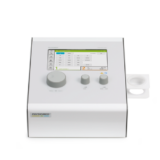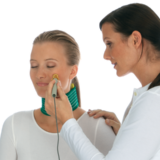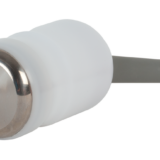Highlightfeatures
- Two-channel electrotherapy including 21 currents
- Alternating and simultaneous stimulation
- Manual release key for emergency shut-off or intentional exercises (option)
- Warning in case of intensity exceeding
- Simultaneous therapy
- Vacuum application with PHYSIOVAC-Expert (option)
Medium frequency currents:
- IF (Classic interference current)
- AMF (Bipolar interference current)
- MT (Medium-frequency muscle stimulation)
- KOTS (Russian stimulation)
Low frequency currents:
- G (Galvanisation)
- GMC (Galvanisation with microcurrent)
- DF (Diadynamic current diphasé fixe)
- MF (Diadynamic current monophasé fixe)
- CP (Diadynamic current modulé en courtes périodes)
- LP (Diadynamic current modulé en longues périodes)
- UR (Ultra stimulation current acc. to Träbert)
- HV (High voltage current)
- TENS (Transcutaneous electric nerve stimulation)
- MENS (Electric nerve stimulation with microcurrent)
- IG 30 (Pulse galvanization 30)
- IG 50 (Pulse galvanization 50)
- FM (Frequency-modulated current)
- STOCH (Stochastic current)
- FaS (Faradic surge current)
- HVS (Current mode with high voltage stimulation characteristics)
- T/R (Pulses with adjustable parameters)
Diagnostics
- Faradic excitability test
- Medium-frequency test (Lange)
- Accommodation quotient
- Rheobase/chronaxy
- I/T curve (with graphical visualization of the curve profile)
- I/T curve – quick test
- 1 and 3 MHz ultrasound
- Ergonomic ultrasound transducers made from biocompatible titanium
- Continuous or pulsed energy output
- Subaqueous treatment
- Perfected user guidance through combination of 7“ touch screen and PHYSIOMED one-button operation
- Comprehensive overview of the therapy parameters including all therapy timers
- Treatment index with extensive therapy and dosage suggestions, treatment pictures and intelligent filtering functions based on body region, therapy form, desired therapy effect or per alphabet for quick location of the desired treatment proposal
- Easy-to-use and extensive memory menu with cocktail and history function
- Multifunctional intensity controls allowing for fast intensity reduction and quick switching between channels
- Logical colour coding of electrotherapy and vacuum application accessories for quick and accurate allocation of channels and polarity
- SD card slot for product updates
for super-fast and clear working

based on body region, therapy form, desired therapy effect or per alphabet for quick location of the desired treatment proposal

Perfected user guidance through combination of 7″ touch screen and PHYSIOMED one-button operation for comprehensive overview of the therapy parameters including all therapy timers; multifunctional intensity controls allowing for fast intensity reduction and quick switching between channels

enables impressively simple saving and calling up of the most popular applications – only two clicks to the therapy!

Easy-to-use and extensive memory menu with cocktail function

with graphical visualization of the curve profile

Warnings in case of intensity exceeding

Logical colour coding of electrotherapy and vacuum application accessories for quick and accurate allocation of channels and polarity

The fundamental principle of special electrotherapy methods e.g. for spastic cerebral palsy, spasms following apoplectic insult and adductor spasms is the stimulation of the Golgi tendon organs, which in turn is aimed at inhibiting muscle spasticity at bone marrow level. Directly following inhibition of the affected muscle, in the second circuit the antagonistic muscles are stimulated. Dr. Felipe Medina presents an example of the adjuvant therapy option in a video.
Clean currents
Quite a few electrotherapy instruments today no longer emit stimulation currents in the form described in teaching manuals, and on which efficient electrotherapy is proven to be based. Instead of this – and in many cases due to cost savings – similar, but not identical, curve forms are used. Nobody knows exactly whether these cause the desired effects in tissue in the same way as the original currents. Instead of medium frequency currents, for example, low frequency ones are generated, and vice versa. In a direct comparison, the difference between ”genuine“ and ”similar“ currents can often be felt, but it only becomes visible when the current curves are viewed on an oscilloscope. Galvanic currents with spikes can be found, distorted instead of harmonic sinusoidal curves, or even deformed envelopes of diadynamic currents.
PHYSIOMED distances itself firmly from this trend of compromising therapeutic success only for the sake of maximising profits. PHYSIOMED instruments therefore only supply ‘clean’ currents. This also explains the often heard opinion of competent electrotherapy users, that despite using the same parameters, they obtain better therapeutic results with PHYSIOMED instruments than with other stimulation current instruments.

Therapy information
Electrotherapy is an important element of physical therapy. Current stimulation will treat the tissue via electrodes (plate electrodes, vacuum electrodes, adhesive electrodes) on the selected areas. Depending on the current mode and the selection of parameters (e.g. impulse form, impulse duration, pause time, frequency, intensity) the stimulation current can have significant effects in the following areas of treatment:
- Musculoskeletal pain
- Venous insufficiency/ulcers
- Pressure ulcers
- Muscle strengthening
- Iontophoresis
According to their generation and specific method of treating the tissue the following classifications of the different stimulation currents can be made:
- Medium frequency current: This is an alternating current, which comes from an superposition of a basic frequency (2-9,5 KHz) and a modulation frequency (0-250 Hz). This superposition already takes place within the equipment with the AMF current (amplitude modulated medium frequency current) as well as with the medium frequency currents for muscle stimulation (MT and KOTS). The previously modulated current can therefore be applied via only two electrodes on the patient. With classic interference current IF however, the superposition delivers both frequencies when it reaches the tissue of the patient, for this reason it is essential to always apply four electrodes for treatment. The high therapeutic effectiveness of the medium frequency current is gained through minimal skin irritation with broad penetration and has better acceptance for the patients.
- Impulse current with frequencies under 1000 Hz is classified as low frequency current. With the different low frequency currents DF, MF, CP, LP (diadynamic current) UR (ultra stimulation current), HV (high voltage current), FaS (Faradic surge current), TENS (mono- or biphasic rectangular impulse) and T/R (exponential current) the total range of application is covered. In contrast to the medium frequency current, low frequency current can also be used for increase of muscle strength.
- Galvanic current (B) is a direct current, so that a constant energy current flows through the tissue. Galvanic current will primarily be used for the stimulation of blood flow and pain reduction, as well as ionization (diffusion of medicaments into the tissue with the help of the current).
Ultrasound therapy, along with stimulation current, is one of the popular treatment forms of physical therapy. Therapeutic ultrasound will be used, with the frequency 1 MHz or 3 MHz, as continuous echo or pulse echo. Due to its complex effects ultrasound therapy is classified as mechanical thermal therapy.
Depending on therapy parameters (therapy frequency, echo type, dose, therapy duration and mode) a thermal effect comes from ultrasound therapy (thermal growth and reflecting from barriers to the tissue, for example, bones or joints) or a micro massage in the treated tissue segments is in the foreground.
The effects of the ultrasound therapy can be summarized as the following:
- Musculoskeletal pain
- Venous insufficiency/ulcers
- Pressure ulcers
Ultrasound will be reflected by air so, for the optimum conduction of the ultrasonic waves from the transducer to the tissue, you should use a coupling agent (ultrasound gel) or connect under water (sub-aqua).
Selected use cases
Electrotherapy is beneficial within a broad range of applications, including, but not limited to:
- Arthrosis (knee joint)
- Chondropathia patellae
- Joint effusion
- Radicular syndrome
- Spondylitis ankylosans
- CRPS stage I and II
- Epicondylopathy
- Pain syndrome, post-operative
- Whiplash injury
Ultrasound therapy is beneficial within a broad range of applications, including, but not limited to:
- Achillodynia
- Disc herniation with radiculopathy
- Fibromyalgia
- Insertion tendopathy
- Neuralgia
- Periostitis
- Tendopathy
- Acromioclavicular dislocation
- Epicondylopathy
- Fracture
- Muscle fiber rupture
- Patellar tendinopathy
- Spondylitis ankylosans
- Ulcus cruris
























































